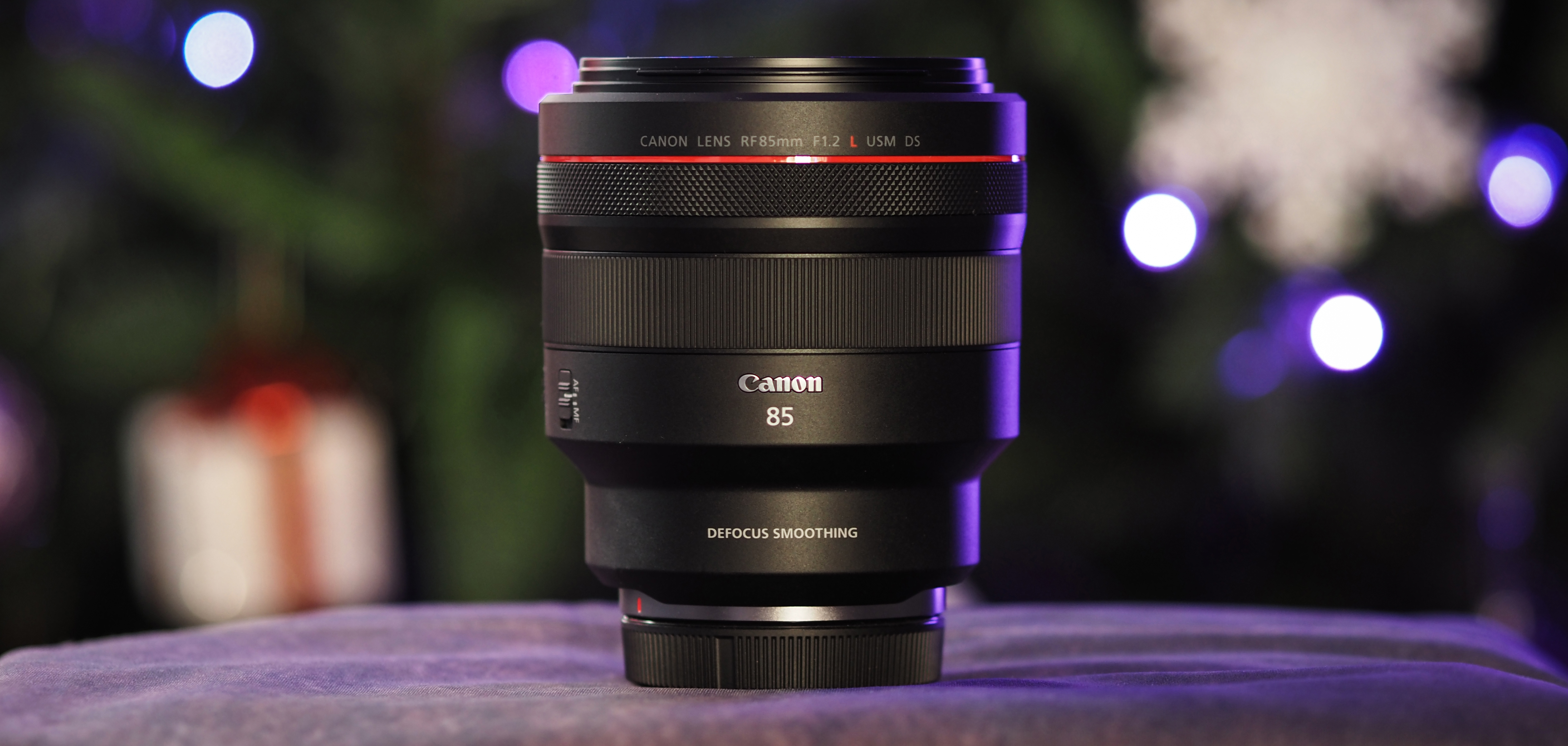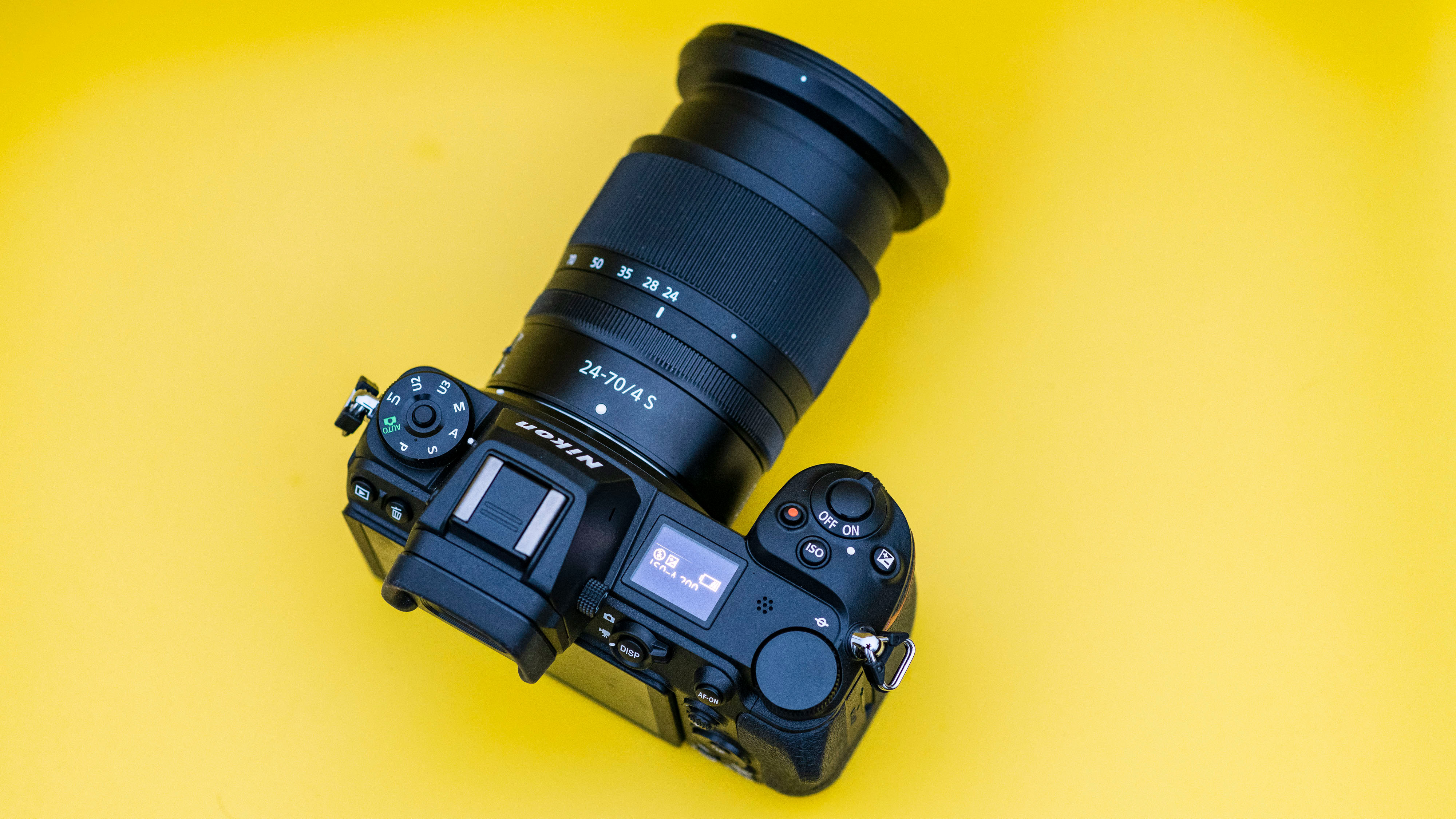Digital Camera World Verdict
The Canon RF 85mm f/1.2L USM DS is almost identical to the standard RF 85mm f/1.2L. As expected, it trades light transmission for impossibly buttery-smooth bokeh – and, somehow, it also possesses even greater sharpness. If background blur is more important to you than low light performance, this Defocus Smoothing optic has the smoothest bokeh you could ask for. The question is, is it TOO smooth, and is it worth an extra $300 / £450?
Pros
- +
Even sharper than the RF 85mm!
- +
Beautiful image quality at f/1.2
- +
Built like a tank
- +
Gorgeously smooth bokeh
Cons
- -
Much pricier than RF 85mm
- -
Reduced transmission at f/1.2
- -
Overbalanced on the EOS R
- -
Is the bokeh TOO smooth?
Why you can trust Digital Camera World
Confession time: the Canon RF 85mm f/1.2L USM DS is this reviewer's most anticipated lens of the year. As a fan of exotic lenses, such as the Canon EF 135mm f/2.8 Softfocus, this has been an eagerly anticipated highlight of 2019 – with suitably lofty expectations.
As a bonus confession, the 'standard' Canon RF 85mm f/1.2L USM is this reviewer's favorite lens for the Canon EOS R. Yes, it's too big and heavy for the body. Yes, it really could do with image stabilization. And yes, it's eye-wateringly expensive… but it's also an eye-wateringly great performer, capable of dreamlike and pin-sharp portraiture that somehow makes the price tag palatable.
So, after months of waiting, how does the boutique Defocus Smoothing version of this magical lens stack up – can it rank among the best Canon lenses, and is the much ballyhooed bokeh really that much different? (Spoiler: Yes. Yes it is…)

Specifications
Full-frame compatible: Yes
Effective focal length: 85mm
Image stabilizer: No
Minimum focus distance: 0.85m
Max magnification factor: 0.12x
Manual focus override: Yes
Focus limit switches: Yes
Internal zoom: N/A
Internal focus: Yes
Filter size: 82mm
Iris blades: 9
Weather seals: Yes
Supplied accessories: Hood, pouch
Dimensions: (Dia x Length): 103.2 x 117.3mm
Weight: 1195g

Key features
As noted (and as attested by the specs above), the RF 85mm f/1.2 DS is technically identical to the RF 85mm f/1.2. There is one key distinction that separates the DS version: a vapor-deposited Defocus Smoothing Coating, applied to both sides of two elements within the lens.
Unlike the aforementioned 135mm Softfocus lens, which uses spherical aberration to introduce blur and bloom to images, this DS Coating will not affect the focal point, so in-focus areas of the image will remain pin-sharp.
Rather, this coating has a high transmittance at the center and a low transmittance toward the periphery. This produces an effect where a sharp outline in a defocused image is blurred even further, with out-of-focus highlights being rendered as discs of light with soft edges rather than hard ones.
The DS effect is most pronounced when shooting at f/1.2, and is lessened as the aperture is stopped down. Since this characteristic is achieved by the DS Coating restricting the amount of light that passes into the lens, the brightness of the lens at f/1.2 is actually about 1⅓ stops darker; Canon states that the true light transmission equates to a T-stop of T2.2.
In other words, this RF 85mm DS lens gives you brilliantly blurred backgrounds, but the tradeoff is that your images will be darker at f/1.2 than they would be on the standard RF 85mm lens. And obviously, unlike the Softfocus lens, this effect cannot be turned off.
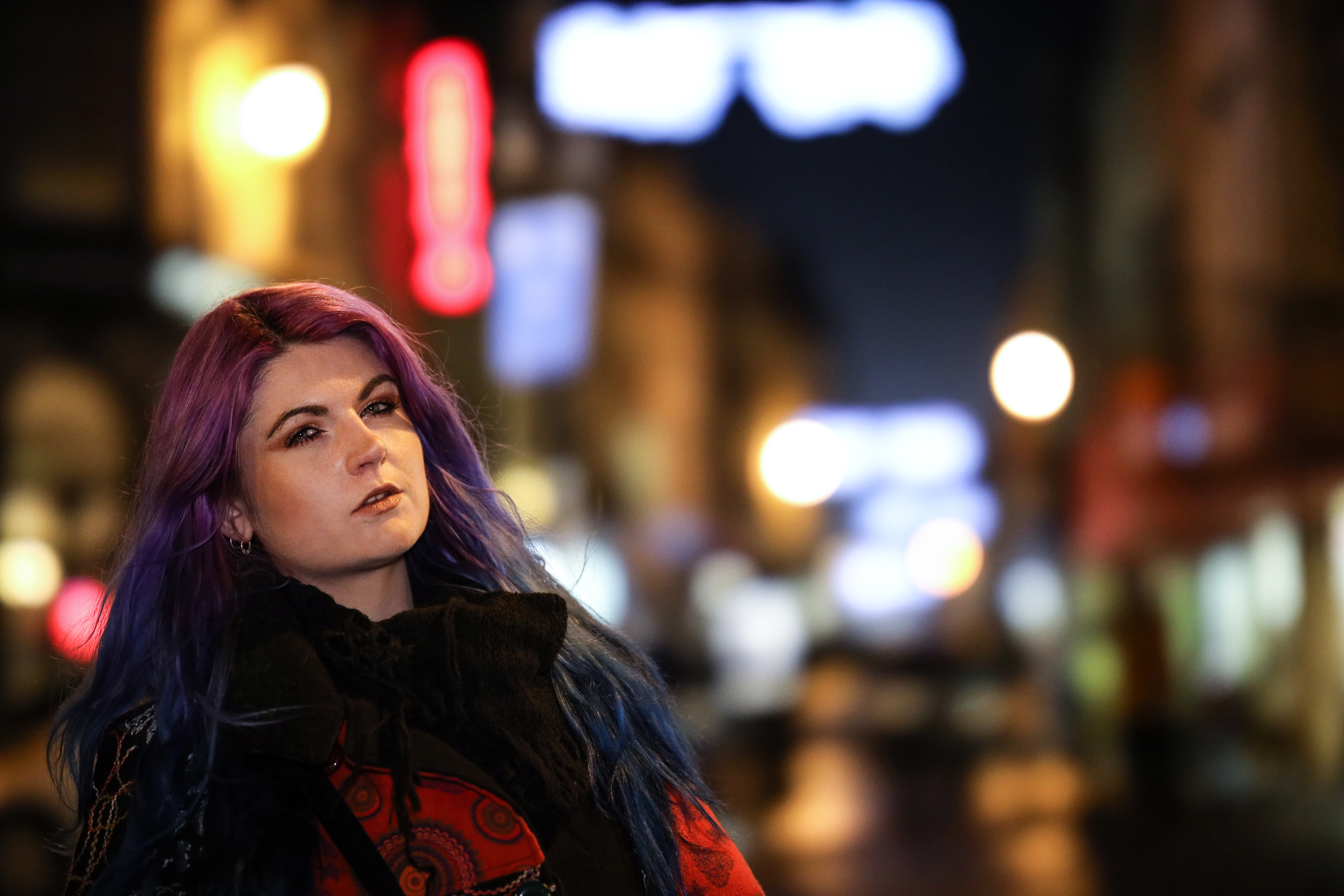
Build & handling
Since the exterior is identical to the standard Canon RF 85mm f/1.2L, the handling of this DS version is exactly the same as its non-defocusing counterpart. Which is to say that it's incredibly front-heavy (thanks to almost 1.2kg of glass loaded mostly towards the nose) and arguably mismatched with the Canon EOS R (and especially with the RP).
Indeed, this lens – along with the Canon RF 50mm f/1.2L USM and Canon RF 28-70mm f/2L USM – is crying out to be paired with a pro Canon EOS R body that possesses in-body image stabilization.
The fact that the standard RF 85mm didn't have IS was less of an issue, thanks to its true 1.2 aperture. However, with an effective 2.2 aperture, the RF 85mm DS is noticeably slower, meaning that the extra stabilization would be very welcome – especially since this lens' party trick is most pronounced when shooting in low light.
Still, if you're used to shooting with a Canon DSLR and the EF 85mm, you'll no doubt have forearms worthy of Popeye that will have no trouble wielding this lens.
The RF 85mm DS is weather-sealed, making it suitable for all-environment shooting, and its build quality is absolutely top notch even by L-series standards. It might weigh a ton, but it is strong and sturdy and will withstand all the knocks and scrapes that professional use will demand of it.
As always for a Canon RF optic, the customizable control ring can be tailored to manipulate your preferred exposure settings such as shutter speed, aperture, EV compensation and ISO.

Performance
Before using this lens, make sure to download the latest Canon EOS R firmware (version 1.6.0 and above) to add support for the RF 85mm f/1.2L USM DS. As noted, since the maximum aperture is effectively T2.2, the latest firmware will enable exposure control in AE to be performed appropriately.
Again, for all intents and purposes, this DS version behaves almost identically to the Canon RF 85mm f/1.2L in use. So you can expect the same quick-as-a-hiccup autofocus with fantastic eye-detecting accuracy (which has been dramatically improved thanks to the new EOS R firmware). And it's worth reiterating that the AF performance of both RF versions of the 85mm f/1.2 are night-and-day better than the molasses-slow EF 85mm f/1.2.
Of course, the $64,000 question (well, more like $300 / £450 question) is just how the bokeh on the DS lens differs from the bokeh on the standard 85mm – and whether it justifies the extra few hundred notes.
The answer is… it depends.
If you're still wondering what is bokeh, it describes the out-of-focus areas of an image – it isn't merely how blurry the background (or foreground) is, though, it's also the quality of that blur. After all, any f/1.2 lens is going to blur the background, but good quality blur – and good quality bokeh – is characterized by its smoothness.
The DS lens unquestionably delivers much smoother blur than the standard 85mm. This is most pronounced when shooting at night, where the highlights are rendered as "bokeh balls" – you can clearly see that the balls from the DS lens are far, far softer than their hard-edged counterparts on the standard 85mm.

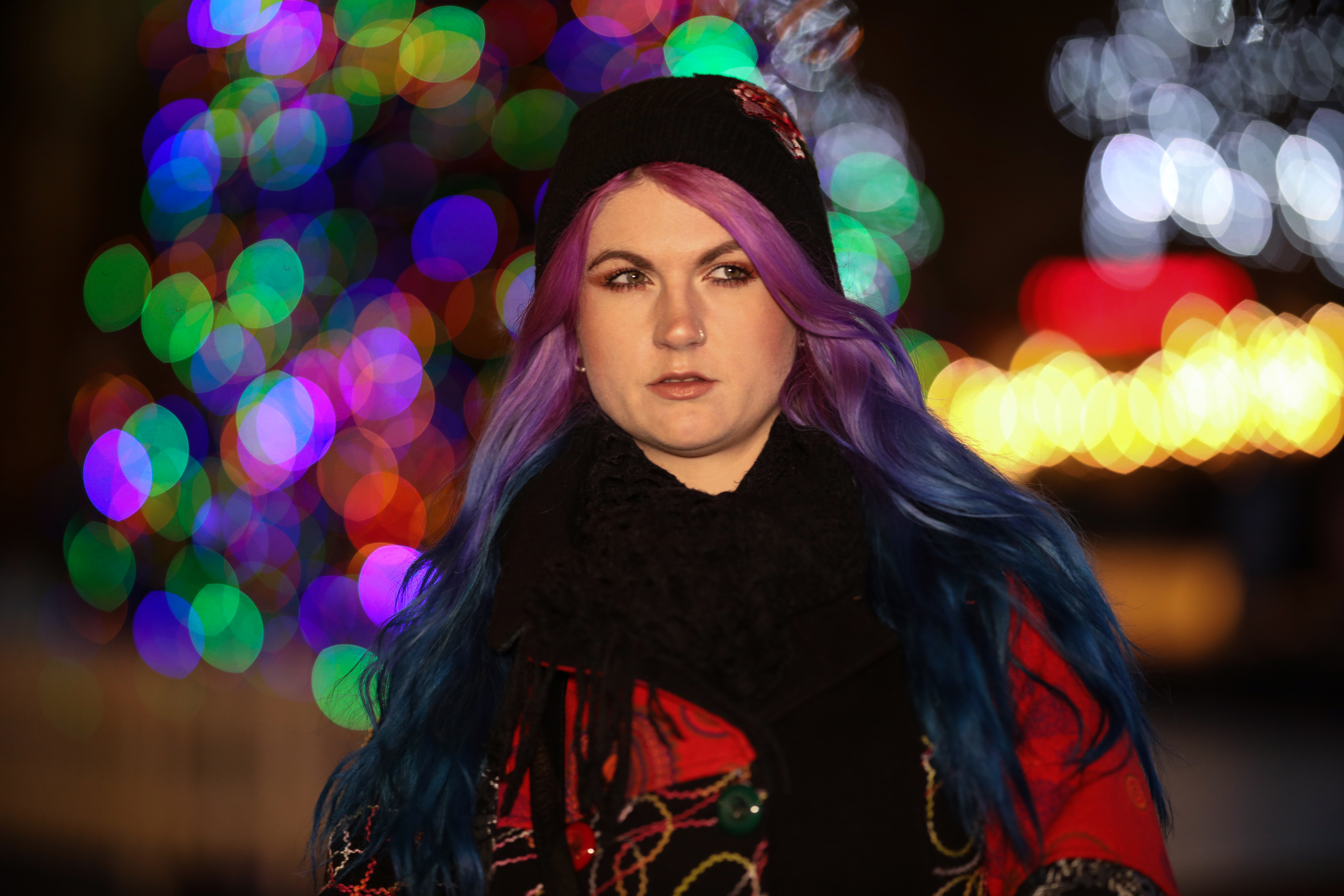
However, the rendering of background blur under conventional daylight conditions is also notably different. While it's far from unpleasant, and though you'd never describe it as "noisy", the bokeh on the standard 85mm is noticeably more agitated, with harsher edges and more pronounced textures. By contrast, the DS lens renders far smoother, creamier bokeh.
At the end of the day, it's purely a matter of preference – do you prefer the harsher, more kaleidoscopic and psychedelic "disco balls" rendered by the standard RF 85mm, or are the soft, feathery bokeh balls produced by the DS lens more your thing. There is no right or wrong answer.
However, given that the DS lens is effectively a T2.2 lens, your images will be captured a good deal darker than they would be on the standard 85mm – meaning that you'll have to either slow your shutter speed or raise your ISO to compensate. So it's a pronounced advantage for the standard RF 85mm that it's a true f/1.2 lens and behaves accordingly (again, the DS lens still possesses the same depth of field characteristics as an f/1.2 optic; only the light transmittance is affected).
The image below the lab data illustrates the difference in exposure, as well as bokeh, recorded by each lens. Which optical effect you prefer, and the extent to which you are willing to boost your ISO or shutter, will dictate which lens is right for you.

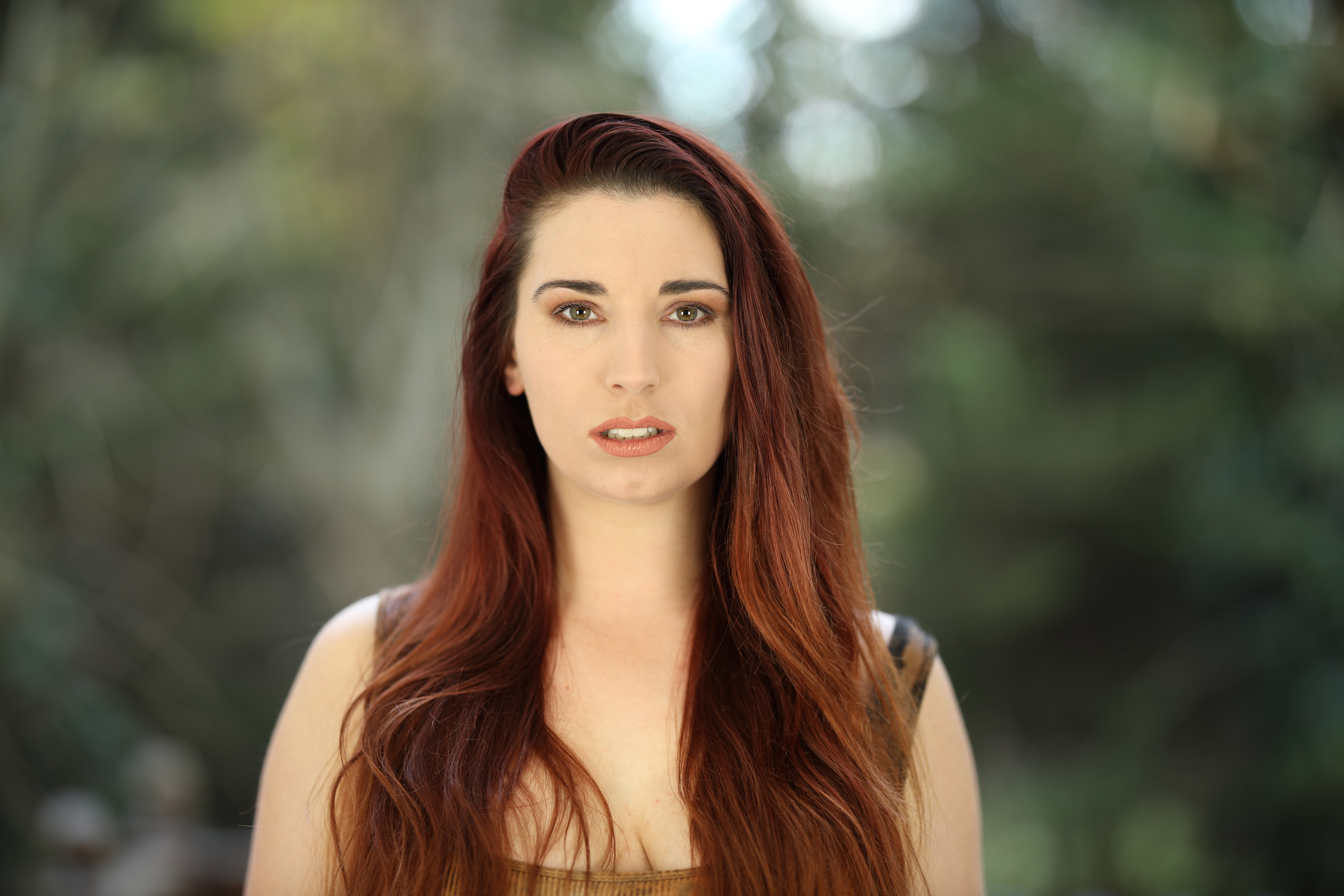
Lab data
We run a range of lab tests under controlled conditions, using the Imatest Master testing suite. Photos of test charts are taken across the range of apertures and zooms (where available), then analyzed for sharpness, distortion and chromatic aberrations.
We use Imatest SFR (spatial frequency response) charts and analysis software to plot lens resolution at the centre of the image frame, corners and mid-point distances, across the range of aperture settings and, with zoom lenses, at four different focal lengths. The tests also measure distortion and color fringing (chromatic aberration).

Sharpness
We measure sharpness in terms of line widths per picture height, and for context, a score approaching 2000 is considered very good.
The RF 85mm f/1.2L USM DS is capable of exceptional centre-frame sharpness, even wide open, and it maintains this performance right through to f/11. Some lenses can be optimised to produce very high centre-frame sharpness, but sharpness may drop off fast towards the corners. The Canon RF 85mm has no such compromises and it maintains excellent sharpness right to the extremes of frame and throughout the aperture range: a very impressive result only possible with top grade optical engineering.
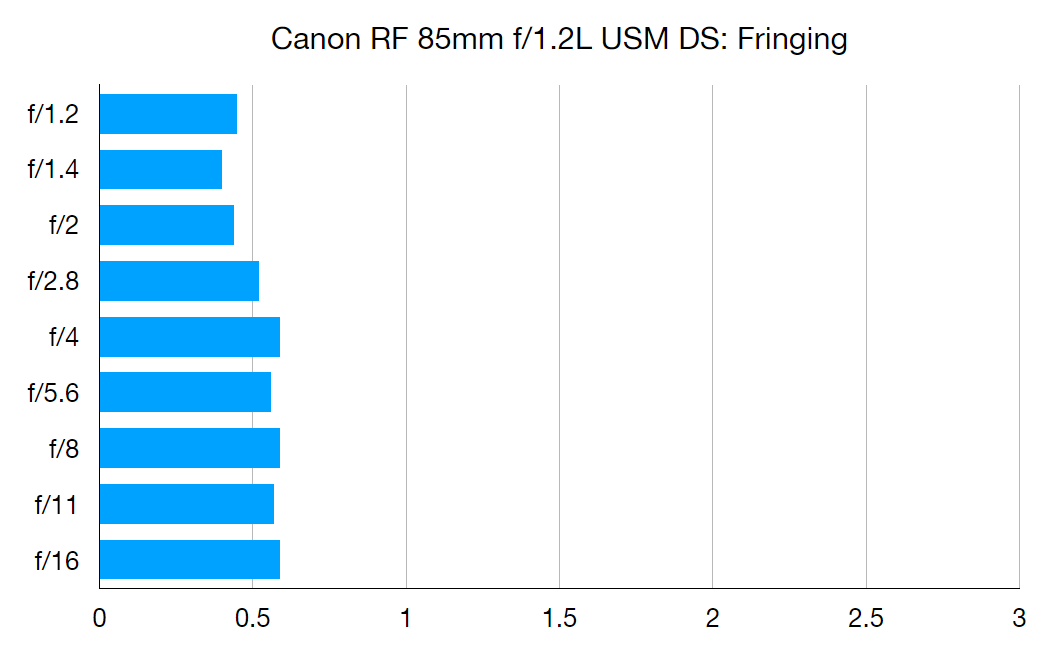
Fringing (lower scores = better)
Chromatic aberration, visible as purple fringing highlighting high-contrast boundaries in an image, is an optical phenomenon that affects all camera lenses.
We wouldn't expect much chromatic aberration from a high quality 85mm prime, and the Canon RF 85mm lives up to expectations. Any score below 1 is considered excellent, and a score around 0.5 indicates you'll have to be an extremely picky pixel peeper to spot any fringing in real world shots.
Distortion: -0.05
This lens is as close to distortion-free as you can get – enough said!

Verdict
The Canon RF 85mm f/1.2L USM DS is the nichest of niche lenses; this is the closest that Canon has ever come to making a Lensbaby-esque special effect optic. It renders the smoothest, creamiest, dreamiest bokeh we've ever experienced on a lens – the DS coating takes this beyond even f/0.95 lenses in terms of noise-free blur.
However, it is significantly more expensive than the standard Canon RF 85mm f/1.2L USM lens – which itself was already significantly more expensive than most 85mm lenses out there.
As a tool for a high end professional portrait photographer or wedding photographer – and that is, after all, where this lens is aimed (and priced) – the 85mm DS bestows the ability to shoot beautiful images with a unique quality. And while no lens is really worth three grand, a lens that does something this special might actually justify that price tag.
Due to its price and no doubt smaller production runs, we see this lens being much like the Nikkor Z 58mm f/0.95 S Noct. It's exotic, expensive and excellent, and its relative scarcity will make it a thing of legend whose mythical status only grows as the years pass.
Read more:
The best camera for portraits in 2019

James has 22 years experience as a journalist, serving as editor of Digital Camera World for 6 of them. He started working in the photography industry in 2014, product testing and shooting ad campaigns for Olympus, as well as clients like Aston Martin Racing, Elinchrom and L'Oréal. An Olympus / OM System, Canon and Hasselblad shooter, he has a wealth of knowledge on cameras of all makes – and he loves instant cameras, too.
